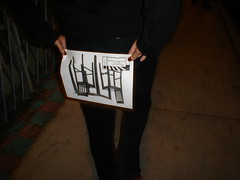Personally, I think there’s a wide spectrum when it comes to whether or not you outline before you write. Yes, okay, having an outline or not having an outline is pretty cut-and-dried, but there are a lot of in betweens:
- An idea for an opening
- An idea for a beginning and a middle
- An idea for a beginning, a middle and an end (a mental outline, perhaps?)
- Ideas for several major guideposts in the story (written down?), with room to figure out how to move between them
- A written outline of the major guideposts and all the transitions between them.
- A chapter-by-chapter synopsis of the story.
- A scene-by-scene spreadsheet, possibly including dialogue, setting, exposition.
 Once upon a time, I was at the pantser (as in “by the seat of your pants”) end of the spectrum. And my stories were often a mess. (Winchester Mystery Story, anyone?) Whether or not they’d turn out all right was hit-or-miss.
Once upon a time, I was at the pantser (as in “by the seat of your pants”) end of the spectrum. And my stories were often a mess. (Winchester Mystery Story, anyone?) Whether or not they’d turn out all right was hit-or-miss.
Then I got into a larger project: parallel novels written simultaneously with a friend. We had to work to coordinate our timelines. There was no way to pants this without ruining one another’s books. I broke down and plotted. And to my surprise, it was even better than pantsing!
But while I’m definitely a plotting convert, I’m not a hard-core-plan-every-scene-to-the-final-detail kind of writer. Like pantsers (and probably most plotters to some extent), I need at least a little discovery and creativity to make drafting fun for me. I’m still experimenting at how much discovery vs. planning I need—my last draft was a little short on the planning. It wasn’t until I sat down and figured out my path in a little more detail that I could finish the book. (And I’m going to need to add some more structure in some parts—that darn sagging middle!)
So where do you fall? How did you come to be a plotter or pantser?
Photo by fracacta


Total pantser here. Although, I have been outlining a little recently. I put my major and minor plot points down, and have to figure out what goes between, but I LOVE getting to discover it. Probably why I don’t write everything down. I just love listening to my characters, and I let them take me wherever they want to go. Cheesy, but it’s true.
Like Chantele, I like to have a basic outline to follow but within that outline I’m a pantser =) I find my characters surprise me quite often if I don’t have everything planned for them.
I used to be a total pantser. Now I am a combination. I usually have a vague idea of where I want the story to end, but nothing too specific. I usually plot a few chapters ahead, but not always. I need the freedom of pantsing to keep me in the story and give my characters room to be themselves. Plotting the whole story is a waste of time for me. I would never keep to the outline.
I’m a total plotter, down to even knowing what I’m going to work on each and every day. That doesn’t mean that things don’t take me by surprise, though. I’ve been known to have scenes, conversations, and even characters appear that I had not accounted for in my carefully written out outline. And that doesn’t bother me at all (it usually makes things so much better).
I’m working both angles too. I’m using Randy Ingermanson’s Snowflake Method to develop ideas for the story and characters, but I’m placing the scenes I come up with into Larry Brooks’ “Beat Sheet” framework. I’m not going any deeper than the scene level with plotting, and in some cases, not even that far because I’m not sure what’s going there yet. That’s the point where my writing process becomes a bit more “organic.”